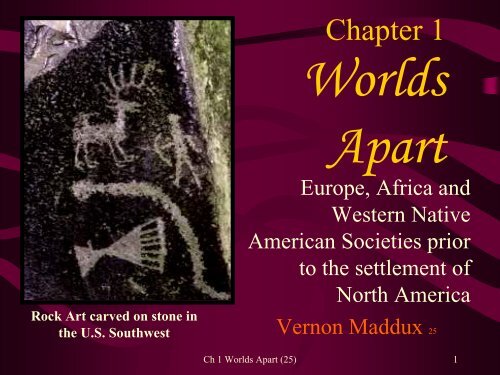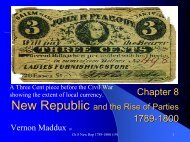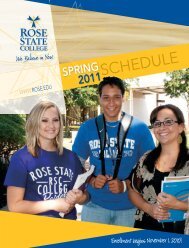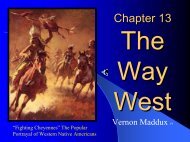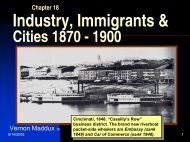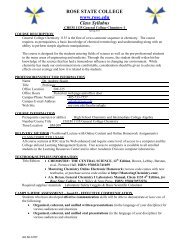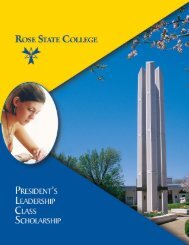Chapter 1 World's Apart
Chapter 1 World's Apart
Chapter 1 World's Apart
Create successful ePaper yourself
Turn your PDF publications into a flip-book with our unique Google optimized e-Paper software.
<strong>Chapter</strong> 1<br />
Worlds<br />
Rock Art carved on stone in<br />
the U.S. Southwest<br />
<strong>Apart</strong><br />
Europe, Africa and<br />
Western Native<br />
American Societies prior<br />
to the settlement of<br />
North America<br />
Vernon Maddux 25<br />
Ch 1 Worlds <strong>Apart</strong> (25) 1
Humans From the Rift Valley in<br />
Africa Spread Around the World<br />
3,000,000 – 12,500 yrs ago<br />
From Africa through Asia to India to China north to Bering land bridge<br />
Ch 1 Worlds <strong>Apart</strong> (25) 2
Bering Strait<br />
The first three waves of Human Beings in North<br />
America crossed from the West end of the Bering<br />
Land Bridge into Alaska perhaps 16,000 years ago<br />
following the migration of large animals.<br />
Land Bridge<br />
Wisconsin Glacial Period<br />
24,000-14,000 Years Ago<br />
Starting 24,000 years ago<br />
Glaciers covered North<br />
America for 10,000 years.<br />
Abundant evidence of<br />
humans is found in Eastern<br />
Siberia and China but not<br />
in N.A. before 16,000 ya<br />
16,0000 ya, ice free corridors<br />
opened south along the<br />
Rocky Mtns. permitting<br />
people to cross the landbridge<br />
into North America.<br />
14,000 ya. the glaciers melted<br />
flooding Bering land-bridge.<br />
Ch 1 Worlds <strong>Apart</strong> (25) 3
Before Columbus, North Americans<br />
were transplanted Old World Asians<br />
• All of the oldest (by far) human<br />
material are found in the Old World.<br />
• There is no evidence that humans<br />
evolved first or independently in the<br />
New World.<br />
• Blood types, DNA and primary<br />
genetic characteristics for all Native<br />
American tribes are very nearly the<br />
same, coming from a small pool of<br />
original people who were all directly<br />
related to those found in NE Asia:<br />
Siberia; Mongolia; China.<br />
1880. Wild Hog, a Northern Cheyenne<br />
warrior, never grew facial hair. His DNA and<br />
features are similar to those found in ancient<br />
China<br />
Ch 1 Worlds <strong>Apart</strong> (25) 4
Oldest Evidence for Humans in either North<br />
or South America is 12,500 years ago<br />
Monte Verde in Southern Chile’, the<br />
site of the oldest known human<br />
habitat in the Western Hemisphere.<br />
• Monte Verde, Chile, is the<br />
oldest human occupation site in<br />
the New World, dating to<br />
12,500 years ago, 1,300 years<br />
earlier than Clovis Point Man,<br />
(New Mexico).<br />
– This is the first known human<br />
habitation found in North or<br />
South America.<br />
• Either humans came across the<br />
Land Bridge earlier, perhaps 15-<br />
18,000 years ago, and left no<br />
trace or they arrived in Chile<br />
some other means-possibly by<br />
coast hopping.<br />
Ch 1 Worlds <strong>Apart</strong> (25) 5
Monte Verde Map<br />
Ch 1 Worlds <strong>Apart</strong> (25) 6
Ancient Technology The incredible Clovis Point<br />
Clovis Point (right) 5” long; Folsom Point<br />
(left) 3” long. Both were found in New<br />
Mexico in 1929. Examples have been found<br />
all over North America, each example made<br />
to the same exacting standard-as if from an<br />
existing model or pattern.<br />
• 1929. Clovis spear points for<br />
killing large game animals were<br />
first discovered in Blackwater<br />
Draw near Clovis, New Mexico.<br />
• The first Clovis point was found<br />
imbedded in a mammoth bone,<br />
which dated to 11,000 years ago.<br />
• Since the first discovery,<br />
thousands of Clovis and the<br />
smaller Folsom points have been<br />
discovered all over North<br />
America, across Mexico and<br />
even in northern South America.<br />
Ch 1 Worlds <strong>Apart</strong> (25) 7
Blackwater<br />
Draw, NM<br />
• Clovis Points were first<br />
discovered in 1929 in<br />
Blackwater Draw, near<br />
Clovis, New Mexico.<br />
• Local rancher Ridgely<br />
Whiteman found a spear<br />
point imbedded in a piece<br />
of mammoth bone and<br />
sent them to the<br />
Smithsonian Institute but<br />
at first there was minimal<br />
interest. (National Geographic,<br />
Dec., 2000, p. 45).<br />
Ch 1 Worlds <strong>Apart</strong> (25) 8
800-1035 Vikings Dominate Europe<br />
Northmen knew of North America 500 years before Columbus<br />
A Viking fighting 1000 AD. Longship<br />
“Vikings” (Denmark-N. Germany;<br />
Norway-Sweden) developed two<br />
ship designs-a slim fighting<br />
Longship (left) and a fat Knarr ,<br />
carrying cargo over open oceans.<br />
The Scandinavian farmers took to<br />
the sea, raiding, pillaging, looting,<br />
settling on the best farmlands in<br />
Ireland, England, France, Iceland,<br />
and ultimately, in Greenland.<br />
Two large Greenland settlements<br />
were established by 1000 AD and<br />
flourished 400 years before<br />
diminishing and dying out
1000 AD, Viking Leif Eriksson explores<br />
but does not colonize N. America<br />
Ch 1 Worlds <strong>Apart</strong> (25) 10
England before Columbus<br />
• 1035. The Viking Era ended when king<br />
Knut the Great died ruling England,<br />
Denmark, Norway and Sweden.<br />
• 1066. French-Viking Duke William<br />
Ragnvald, “William the Conqueror,”<br />
invades England; creates feudal system.<br />
– 1154. King Stephen Ragnvald is replaced<br />
by Norse-Frenchman Henry II, starting<br />
the Plantagenet line of English kings.<br />
• 1485. Henry VII Tudor kills Richard<br />
III, the last Plantagenet, in battle. He<br />
marries Richard’s sister Elizabeth of<br />
York, uniting all claims to the throne.<br />
• Henry VII claimed Anglo-Saxon lineage to<br />
Alfred the Great (871-899).<br />
The British Isle<br />
Ch 1 Worlds <strong>Apart</strong> (25) 11
Greenland, Iceland, Norway, Ireland,<br />
Britain, France, Spain, Portugal, North<br />
Africa viewed from space. A nice day.<br />
Europe & Africa<br />
Impoverished on the eve of Discovery<br />
• 1492. Spain wins its 700<br />
year protracted war<br />
against Islamic Moors.<br />
– Iterant Italian sailor<br />
Christopher Columbus<br />
presents his (not new)<br />
idea to Queen Isabelle<br />
and King Ferdinand.<br />
• Spanish-Portuguese had the<br />
best ships and navigators<br />
but the English, Dutch and<br />
French are eager to learn.<br />
– Columbus’ success results<br />
in the Columbian<br />
Exchange.<br />
• At this time, West African<br />
Societies are nearly as<br />
advanced as Europe.<br />
Ch 1 Worlds <strong>Apart</strong> (25) 12
. Timbuktu<br />
Zimbabwe<br />
Ancient Kingdoms of North & Central Africa<br />
Africa<br />
Just before 1492<br />
• Great African Empires<br />
existed from Egypt to<br />
Zimbabwe.<br />
• Most Africans brought<br />
to Americas came from<br />
West-Southwest Africa.<br />
• Timbuktu with 70,000<br />
people on the Niger<br />
River was capitol of the<br />
Songhai empire. Its wars<br />
provided hundreds of<br />
thousands captives to the<br />
Portuguese and Spanish<br />
between 1500-1600.<br />
Ch 1 Worlds <strong>Apart</strong> (25) 13
Christopher<br />
Columbus<br />
• Born c. 1451 Genoa, Italy<br />
• Died May 20, 1506<br />
• Valladolid, Spain<br />
• Occupation maritime<br />
explorer for the Crown of<br />
Castile<br />
• Portrait by Alejo<br />
Fernández, painted<br />
between 1505 and 1536.<br />
Ch 1 Worlds <strong>Apart</strong> (25) 14
16 th century Tudor England<br />
King at age 17, he married 6 times and created Protestant England<br />
King Henry VIII Tudor<br />
Henry Tudor ruled England for half<br />
of the 16 th century (1509-1547).<br />
Thwarted in gaining a divorce decree<br />
from the Pope, he accidentally<br />
created the Protestant Reformation<br />
by making himself head of the<br />
English Church.<br />
Threatened by Catholic Europe, he<br />
developed English nationalism and<br />
broke England free of European<br />
domination.<br />
As part of the deal to let him head the<br />
church, he agreed to permit<br />
scholars to translate the Bible from<br />
Latin to English.<br />
Ch 1 Worlds <strong>Apart</strong> (25) 15
Catherine 1485-1536<br />
she is buried at Peterborough Abbey a<br />
Royal Queen of England.<br />
Catherine<br />
of Aragon<br />
1488. Youngest child of the Spanish<br />
monarchs Ferdinand and Isabella who<br />
sponsored Columbus, Catherine was<br />
betrothed at age 3 to the English<br />
Prince Arthur age 2 son of Henry VII.<br />
1509. Arthur died and his brother Henry<br />
became king. He married Queen<br />
Catherine who, with difficulty, bore<br />
the infamous “Bloody Mary.”<br />
1536. Imprisoned for years as Henry’s<br />
ex-wife, Catherine died at age 51 at<br />
Kimbolton Castle the same year that<br />
Henry executed her replacement, Ann<br />
Boleyn.<br />
Ch 1 Worlds <strong>Apart</strong> (25) 16
1533. Henry’s great flame was<br />
Anne Boleyn, who became<br />
pregnant with Elizabeth even<br />
though the Pope still had not<br />
granted an annulment for Henry<br />
from Catherine.<br />
Desperate, Henry VIII ordered the<br />
Archbishop of Canterbury to<br />
grant him an annulment and to<br />
cut ties with Rome. This raised<br />
the king to be the head of the<br />
English church.<br />
1536. Unfortunately for Anne,<br />
Henry’s jealous court suspected<br />
her of adultery and he was forced<br />
to cut off her head.<br />
Anne Boleyn<br />
Anne Boleyn 1502-1536<br />
Ch 1 Worlds <strong>Apart</strong> (25) 17
Mary Tudor 1515-1558<br />
Henry’s eldest daughter is the First Queen<br />
Regent of England, reigning 1553-58<br />
“Bloody Mary”<br />
• Mary was the first English Queen who<br />
reigned in her own right rather than through<br />
a marriage to the king.<br />
• A devout Catholic, she was courageous,<br />
stubborn, tough, her fierce character molded<br />
by her difficult early years.<br />
• After her half-brother Edward VI's death,<br />
most nobles backed her against her uncle<br />
Lord Northumberland who pressed for his<br />
daughter-in-law Lady Jane Grey to be queen.<br />
• Queen Mary captured the throne then<br />
executed her uncle, Duke of Northumberland,<br />
his son and Lady Jane Grey, both innocents.<br />
Ch 1 Worlds <strong>Apart</strong> (25) 18
Elizabeth I Tudor Queen Regent 1558-1603<br />
“The Virgin Queen” • Daughter of Henry and Anne<br />
Boleyn, Elizabeth was a half-sister<br />
to the future Queen Mary. She took<br />
over when Mary died in 1558.<br />
• A gentle Protestant, she restored the<br />
Reformation and encouraged the<br />
Puritan reforms.<br />
– She refused to marry (hence “The<br />
Virgin Queen”).<br />
She promoted intense competition with<br />
Spain and encouraged her admirals<br />
to loot their treasure ships.<br />
1586. Given free reign, her inspired<br />
admirals defeated the Great Armada.<br />
Elizabeth Tudor 1533-1603<br />
• 1603. Leaving no heir, her Scottish<br />
cousin, James Stuart, king of Scotland,<br />
succeeded her.<br />
Ch 1 Worlds <strong>Apart</strong> (25) 19
Sir Francis Drake<br />
1540-1596<br />
Born on a Devonshire farm, he<br />
ran away in 1558 to sail with his<br />
cousin, Capt. Jack Hawkins<br />
The Spanish feared Drake so<br />
much that he was called "El Draque"<br />
The Dragon. He is one of the most<br />
renowned sailors in history. He led<br />
several expeditions against the<br />
Spanish Main as well as daring to<br />
attack the Spanish city of Cadiz.<br />
• 1577. Drake was the first Englishman<br />
to circumnavigate the globe.<br />
• 1588. Drake helped defeat the Spanish<br />
Armada off the English coast.<br />
• No other seaman, not even Nelson,<br />
played a more important role in<br />
English Naval history than Francis<br />
Drake.<br />
Ch 1 Worlds <strong>Apart</strong> (25) 20
The Spanish Armada<br />
June-Dec 1588<br />
• 1587. King Phillip decided to<br />
use his American gold and<br />
silver to build and outfit<br />
enough ships to attack and<br />
invade England to forcibly<br />
bring the island back into the<br />
Catholic sphere.<br />
A Spanish war galleon of the Armada<br />
• 1588. Sea captains Hawkins,<br />
Drake and Sir Walter Raleigh<br />
defeated the great armada and<br />
by doing so, drove Spain into<br />
economic ruin.<br />
Ch 1 Worlds <strong>Apart</strong> (25) 21
Sir Walter Raleigh and the<br />
Sir Walter Ralegh b.<br />
Devonshire 1554- executed 1618<br />
New World<br />
• Raleigh was Elizabeth’s favorite beau<br />
and a great explorer. He never landed<br />
in North America but organized and<br />
financed two “Virginia” expeditions.<br />
• 1590. On one voyage, an employee,<br />
Thomas Hariot, brought the first<br />
potatoes from South America to<br />
Ireland.<br />
– Planted on Raleigh's Irish estate<br />
potatoes quickly became the main food<br />
item all across Ireland.<br />
• 1618. Disdained by King James who<br />
desired peace with Spain, Raleigh was<br />
executed in the Tower as scapegoat for<br />
English piracy against the Spanish.<br />
Ch 1 Worlds <strong>Apart</strong> (25) 22
1 st and 2 nd Roanoke<br />
First Attempts at English Settlements<br />
• 1584, July 13. Raleigh financed an<br />
expedition to Roanoke Is (NC).<br />
– Governor Ralph Lane greeted the<br />
brother of the local chieftan who<br />
warmly welcomed the English to the<br />
New World.<br />
1 st Roanoke<br />
* 1584<br />
2 nd Roanoke<br />
1587<br />
“The Lost Colony.”<br />
Two colonies at Roanoke<br />
• Originally 90 men, 17 women, 9<br />
children went ashore. They were<br />
picked up after 10 months (leaving<br />
behind 15 sailors).<br />
• 1587 2 nd Roanoke is founded by 90<br />
men, 17 women and 9 children. The<br />
settlers are discovered missing in<br />
1590. 2 nd Roanoke Colony<br />
vanished.<br />
Ch 1 Worlds <strong>Apart</strong> (25) 23
Settlement of N. America and the Flourishing of<br />
English Arts under Elizabeth-King James Stuart<br />
Before Elizabeth & Shakespeare, most documents in England were written in Latin<br />
• Between 1572-1599,<br />
Shakespeare wrote Love’s<br />
Labours Lost; The Merchant<br />
of Venice; A Midsummer<br />
Night’s Dream; Twelfth<br />
Night and As You Like It .<br />
• Shakespeare’s The Tempest<br />
(1610) was inspired by the loss<br />
of a Second Re-supply ship<br />
which wrecked on Bermuda on<br />
its way to Jamestown.<br />
William Shakespeare 1555-1617<br />
Ch 1 Worlds <strong>Apart</strong> (25) 24
James I Stuart<br />
Scottish Stuart King of England, ruled 1603-1627<br />
1566-1627<br />
• Grandson of Henry VII, son of Mary<br />
Queen of Scots who<br />
Queen Elizabeth executed, James was<br />
born to be king of Scotland.<br />
• When Elizabeth died with no heir, he<br />
was invited by Parliament to rule<br />
England as a Protestant king.<br />
• Raised Catholic, he agreed to honor<br />
the English Protestant Church.<br />
• A caretaker king and weak ruler, he<br />
acted cautiously and permitted<br />
commoners, the Virginia Company,<br />
to explore and settle the New World<br />
without interference.<br />
Ch 1 Worlds <strong>Apart</strong> (25) 25


